Groundwater Quality Modeling and Mitigation from Wastewater Used in Irrigation, a Case Study of the Nile Delta Aquifer in Egypt
Abstract
:1. Introduction
2. Materials and Methods
2.1. Study Area
2.2. Numerical Model
2.2.1. Model Geometry
2.2.2. Boundary Conditions
2.2.3. Hydraulic Parameters
2.2.4. Recharge and Abstraction
2.2.5. Model Hydrological Properties
2.2.6. Model Calibration
2.2.7. Model Scenarios
3. Results
3.1. Effect of Using Untreated Wastewater for Irrigation on Groundwater Quality (Stage 1)
3.2. Effect of Over-Pumping and Using Untreated Wastewater on Groundwater Quality (Stage 2)
3.3. Effect of Over-Pumping Rate and Using Treated Wastewater on Groundwater Quality (Stage 3)
4. Discussion
5. Conclusions
Author Contributions
Funding
Institutional Review Board Statement
Informed Consent Statement
Data Availability Statement
Acknowledgments
Conflicts of Interest
Appendix A
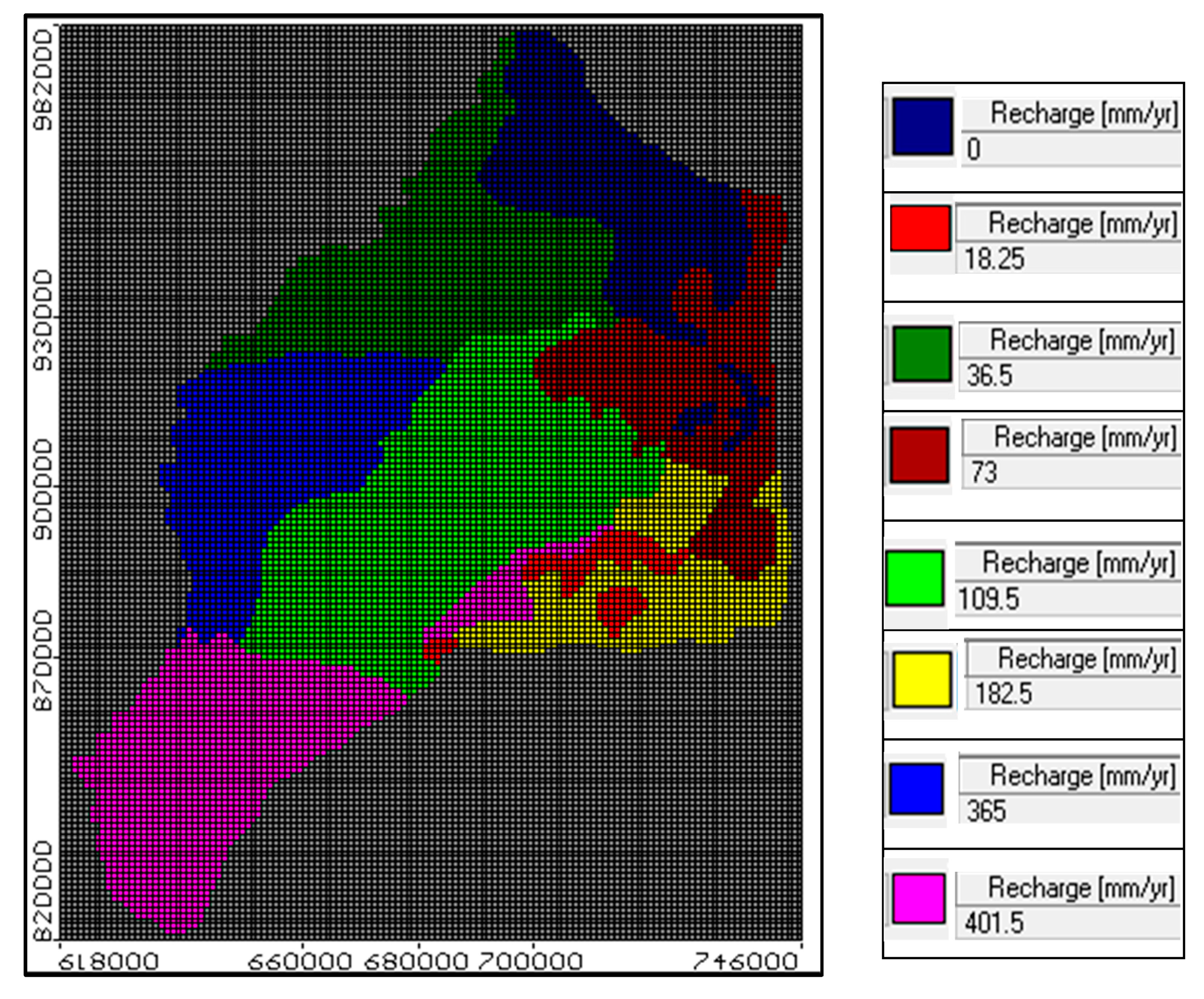
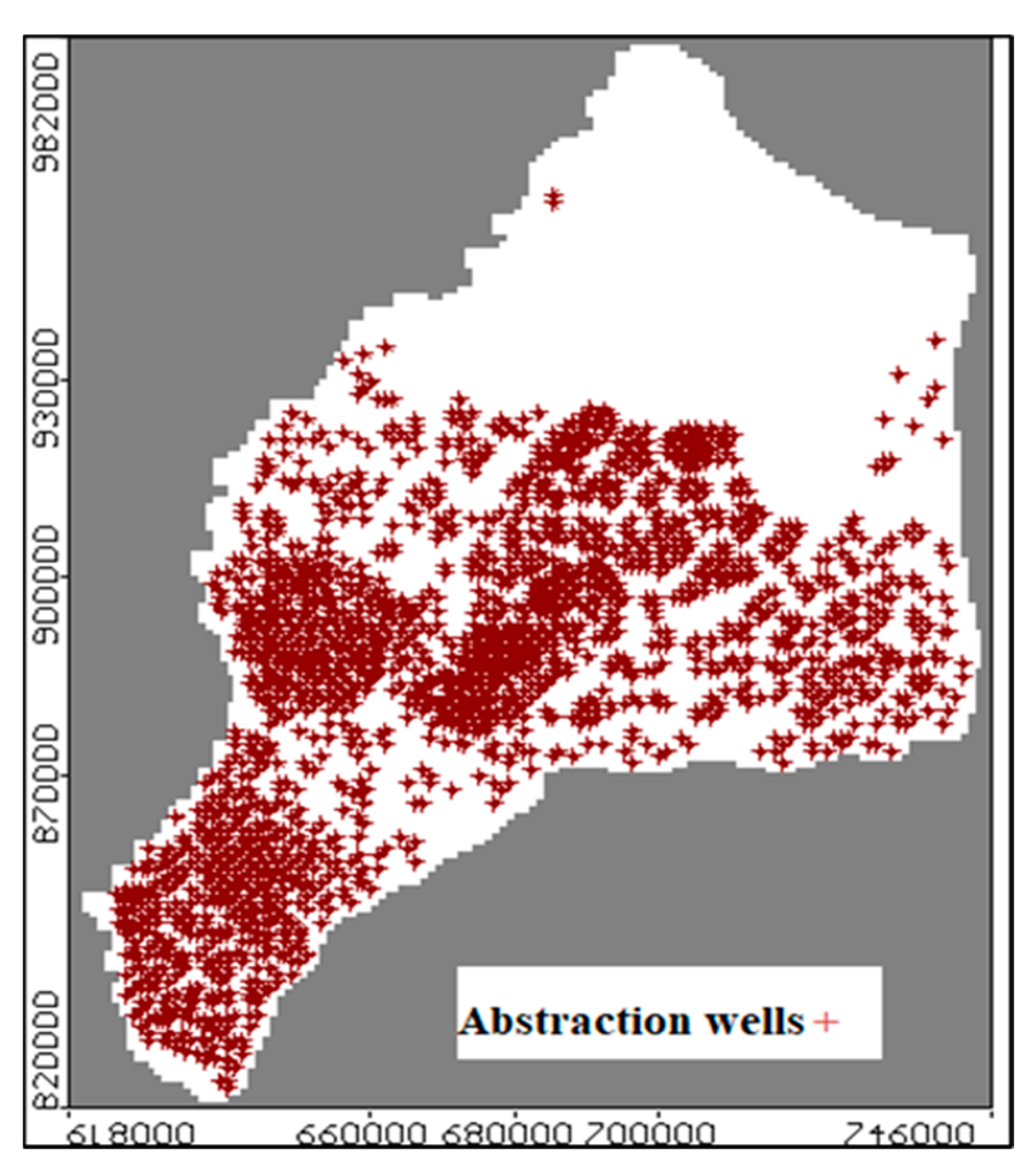
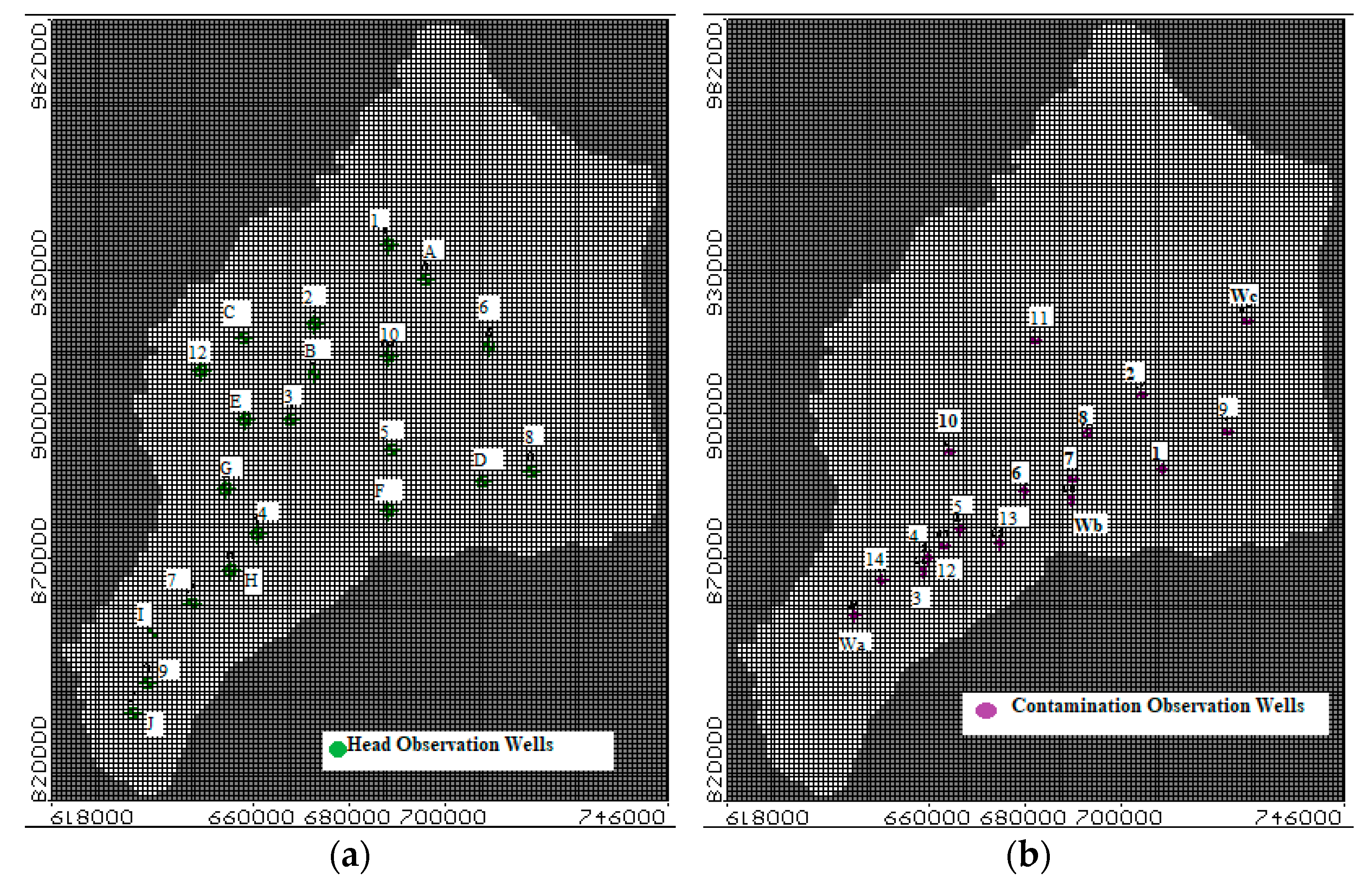
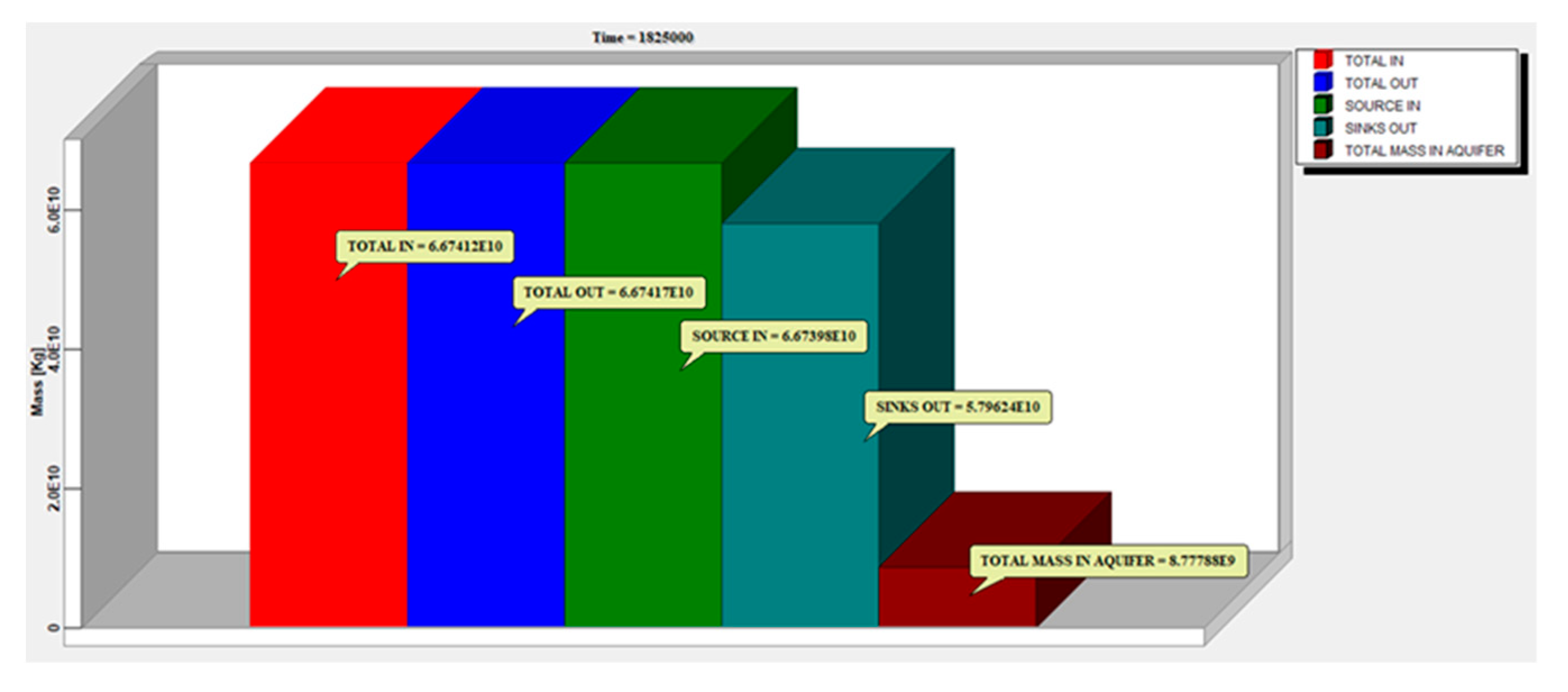
References
- Chan, N.W.; Ku-Mahamud, K.; Karim, M.Z.; Lee, L.K.; Bong, C. Hydrological cycle and cities. In Sustainable Urban Development Textbook; Water Watch Penang & Yokohama City University: Kanagawa, Japan, 2016; pp. 95–104. [Google Scholar]
- Iqbal, M.; Nauman, S.; Ghafari, M.; Parnianifard, A.; Gomes, A.; Gomes, C. Treatment of wastewater for agricultural applications in regions of water scarcity. Significance 2021, 16, 17. [Google Scholar]
- Raslan, A.M.; Riad, P.H.; Hagras, M.A. 1D hydraulic modelling of Bahr El-Baqar new channel for northwest Sinai reclamation project, Egypt. Ain Shams Eng. J. 2020, 11, 971–982. [Google Scholar] [CrossRef]
- Zhang, Y.; Shen, Y. Wastewater irrigation: Past, present, and future. Wiley Interdiscip. Rev. Water 2019, 6, e1234. [Google Scholar] [CrossRef]
- Keraita, B.; Jiménez, B.; Drechsel, P. Extent and implications of agricultural reuse of untreated, partly treated and diluted wastewater in developing countries. CABI Rev. 2008, 2008, 15. [Google Scholar] [CrossRef]
- Mokhtari, T.; Bagheri, A.; Alipour, M. Benefits and risks of wastewater use in agriculture. In Proceedings of the 1st International and the 4th National Congress on Recycling of Organic Waste in Agriculture, Isfahan, Iran, 26–27 April 2012. [Google Scholar]
- Qadir, M.; Wichelns, D.; Raschid-Sally, L.; Minhas, P.S.; Drechsel, P.; Bahri, A.; McCornick, P.G.; Abaidoo, R.C.; Attia, F.; El-Guindy, S.; et al. Agricultural use of marginal-quality water. Oppor. Chall. 2007. [Google Scholar] [CrossRef]
- Van der Hoek, W.; Hassan, M.U.; Ensink, J.H.; Feenstra, S.; Raschid-Sally, L.; Munir, S.; Aslam, R.; Ali, N.; Hussain, R.; Matsuno, Y. Urban wastewater: A valuable resource for agriculture: A case study from Haroonabad, Pakistan. IWMI 2002, 63. [Google Scholar] [CrossRef]
- Miller-Robbie, L.; Ramaswami, A.; Amerasinghe, P. Wastewater treatment and reuse in urban agriculture: Exploring the food, energy, water, and health nexus in Hyderabad, India. Environ. Res. Lett. 2017, 12, 075005. [Google Scholar] [CrossRef] [Green Version]
- Ungureanu, N.; Vlăduț, V.; Voicu, G. Water scarcity and wastewater reuse in crop irrigation. Sustainability 2020, 12, 9055. [Google Scholar] [CrossRef]
- Elbana, T.A.; Bakr, N.; Elbana, M. Reuse of treated wastewater in Egypt: Challenges and opportunities. Unconv. Water Resour. Agric. Egypt 2017, 429–453. [Google Scholar]
- Hassan, A.A.; Nada, A.; Elshemy, M.; Zeidan, B.A. Evaluation of Wastewater Treatment-via-Dilution for Tala Drain, Nile Delta, Egypt. In Towards Water Secure Societies; Springer: Cham, Switzerland, 2021; pp. 63–77. [Google Scholar]
- Abd-Elaty, I.M. Numerical and Experimental Study for Simulating Climatic Changes Effects on Nile Delta Aquifer. Ph.D. Thesis, Faculty of Engineering, Zagazig University, Zagazig, Egypt, 2014. [Google Scholar]
- Abdel-Shafy, H.I.; Kamel, A.H. Groundwater in Egypt issue: Resources, location, amount, contamination, protection, renewal, future overview. Egyptian. J. Chem. 2016, 59, 321–362. [Google Scholar]
- Morsy, W.S. Environmental Management to Groundwater Resources for Nile Delta Region. Ph.D. Thesis, Faculty of Engineering, Cairo University, Cairo, Egipt, 2009. [Google Scholar]
- Donia, N. Model Driven Scenarios for water Quality Control of Bahr El Baqar Drain. In Proceedings of the Twenty-Second International Water Technology Conference, IWTC22, Ismailia, Iran, 12–13 September 2019. [Google Scholar]
- Abdel-Satar, A. Environmental studies on the impact of the drains effluent upon the southern sector of Lake Manzalah, Egypt. Egypt. J. Aquat. Biol. Fish. 2001, 5, 17–30. [Google Scholar] [CrossRef] [Green Version]
- Abd-Elhamid, H.F.; Abd-Elmoneem, S.M.; Abdelaal, G.M.; Zeleňáková, M.; Vranayova, Z.; Abd-Elaty, I. Investigating and Managing the Impact of Using Untreated Wastewater for Irrigation on the Groundwater Quality in Arid and Semi-Arid Regions. Int. J. Environ. Res. Public Health 2021, 18, 7485. [Google Scholar] [CrossRef]
- Abdelmoneem, S.M.; Abd-Elaty, I.; Abdelaal, G.M.; Abd-Elhamid, H.F. Investigating the effect of using treated and untreated wastewater in irrigation on groundwater quality. Egypt. Int. J. Eng. Sci. Technol. 2022, 37, 17–23. [Google Scholar]
- Abd-Elhamid, H.F.; Abdelaal, G.M.; Abd-Elaty, I.; Said, A.M. Evaluation of groundwater vulnerability to seepage from open drains considering different pumping schemes in unconfined aquifers. In Proceedings of the Twenty-First International Water Technology Conference, IWTC21, Ismailia, Egypt, 28–30 June 2018; pp. 28–30. [Google Scholar]
- Paruch, A.M. The impact of wastewater irrigation on the chemical quality of groundwater. Water Environ. J. 2014, 28, 502–508. [Google Scholar] [CrossRef]
- Abd-Elaty, I.; Zelenakova, M.; Straface, S.; Vranayová, Z.; Abu-hashim, M. Integrated modelling for groundwater contamination from polluted streams using new protection process techniques. Water 2019, 11, 2321. [Google Scholar] [CrossRef] [Green Version]
- Ezzeldin, M.M.; El-Alfy, K.S.; Abdel-Gawad, H.A.; Abd-Elmaboud, M.E. Land use changes in the Eastern Nile Delta Region; Egypt using multi-temporal remote sensing techniques. Int. J. Sci. Eng. Res. 2016, 7, 78–98. [Google Scholar]
- CONOCO. Geological Map of Egypt, Scale 1:500,000, Nile Delta, NH-36; Egyptian General Petroleum Corporation: Cairo, Egypt, 1987. [Google Scholar]
- Hammam, A.A.; Mohamed, E.S. Mapping soil salinity in the East Nile Delta using several methodological approaches of salinity assessment. Egypt J. Remote Sens. Space Sci. 2020, 23, 125–131. [Google Scholar] [CrossRef]
- Al-Gamal SEl-Sayed, S.; Atta, E. Exploring surface-and groundwater interactions in East Delta Aquifer using conventional and non-conventional techniques. J. Appl. Geol. Geophys. 2018, 6, 48–58. [Google Scholar]
- Zaki, A.; Swelam, A. First Report Climatology of Nile Delta, Egypt; Ministry of Agriculture and Land Reclamation: Cairo, Egipt, 2017; 32p.
- Eltarabily, M.G.; Negm, A.M. Groundwater management for sustainable development east of the nile delta aquifer. Groundw. Nile Delta 2017, 73, 687–708. [Google Scholar]
- Abd-Elhamid, H.F.; Abd-Elaty, I.; Ramadan, E.M. The impact of climate change and population growth on Groundwater resources in the Eastern Nile Delta Aquifer, Egypt. In Proceedings of the International Conference of Engineering Sciences and Applications, Aswan, Egypt, 27–29 December 2016; pp. 29–31. [Google Scholar]
- Attwa, M.; Basokur, A.T.; Akca, I. Hydraulic conductivity estimation using direct current (DC) sounding data: A case study in East Nile Delta, Egypt. Hydrogeol. J. 2014, 22, 1163–1178. [Google Scholar] [CrossRef]
- Elbeih, S.F.; Madani, A.A.; Hagage, M. Groundwater deterioration in Akhmim District, Upper Egypt: A Remote Sensing and GIS investigation approach. Egypt. J. Remote Sens. Space Sci. 2021, 24, 919–932. [Google Scholar] [CrossRef]
- Abd-Elaty, I.; Javadi, A.A.; Abd-Elhamid, H.F. Management of saltwater intrusion in coastal aquifers using different wells systems: A case study of the Nile Delta aquifer in Egypt. Hydrogeol. J. 2021, 29, 1767–1783. [Google Scholar] [CrossRef]
- McDonald, M.G.; Harbaugh, A.W. A Modular Three-Dimensional Finite-Difference Ground-Water Flow Model; US Geological Survey; USGS: Sunrise Valley Drive Reston, VA, USA, 1988.
- Javandel, I.; Doughty, L.; Tsang, C. Groundwater Transport: Handbook of Mathematical Models. In Water Resources Monograph Series; Wiley: Hoboken, NJ, USA, 1984. [Google Scholar]
- El Haddad, I.M. Hydrogeological Studies and Their Environmental Impact on Future Management and Sustainable Development of the New Communities and Their Surroundings, East of the Nile Delta, Egypt. Ph.D. Thesis, Mansoura University, Mansoura, Egypt, 2002. [Google Scholar]
- Abd-Elaty, I.; Kuriqi, A.; Shahawy, A.E. Environmental rethinking of wastewater drains to manage environmental pollution and alleviate water scarcity. Nat. Hazards 2022, 110, 2353–2380. [Google Scholar] [CrossRef] [PubMed]
- El-Arabi, M. Environmental Impact of New Settlements in Groundwater in a Region in the Nile Delta. Ph.D. Thesis, Faculty of Engineering, Zagazig University, Zagazig, Egipt, 2007. [Google Scholar]
- RIGW (Research Institute for Groundwater). Projected of the Safe Yield Study for Groundwater Aquifer in the Nile Delta and Upper Egypt; RIGW: Cairo, Egipt, 1980. [Google Scholar]
- Riffat, R.; Husnain, T. Fundamentals of Wastewater Treatment and Engineering; CRC Press: Boca Raton, FL, USA, 2011. [Google Scholar]

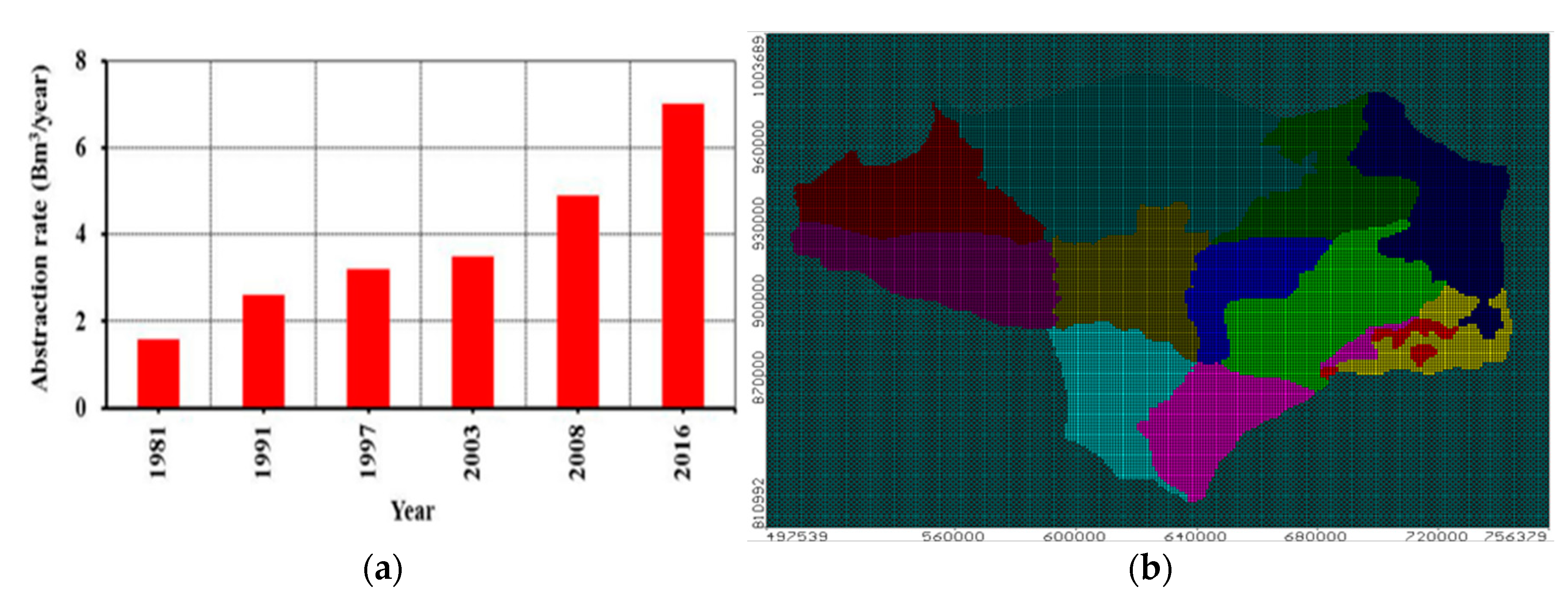
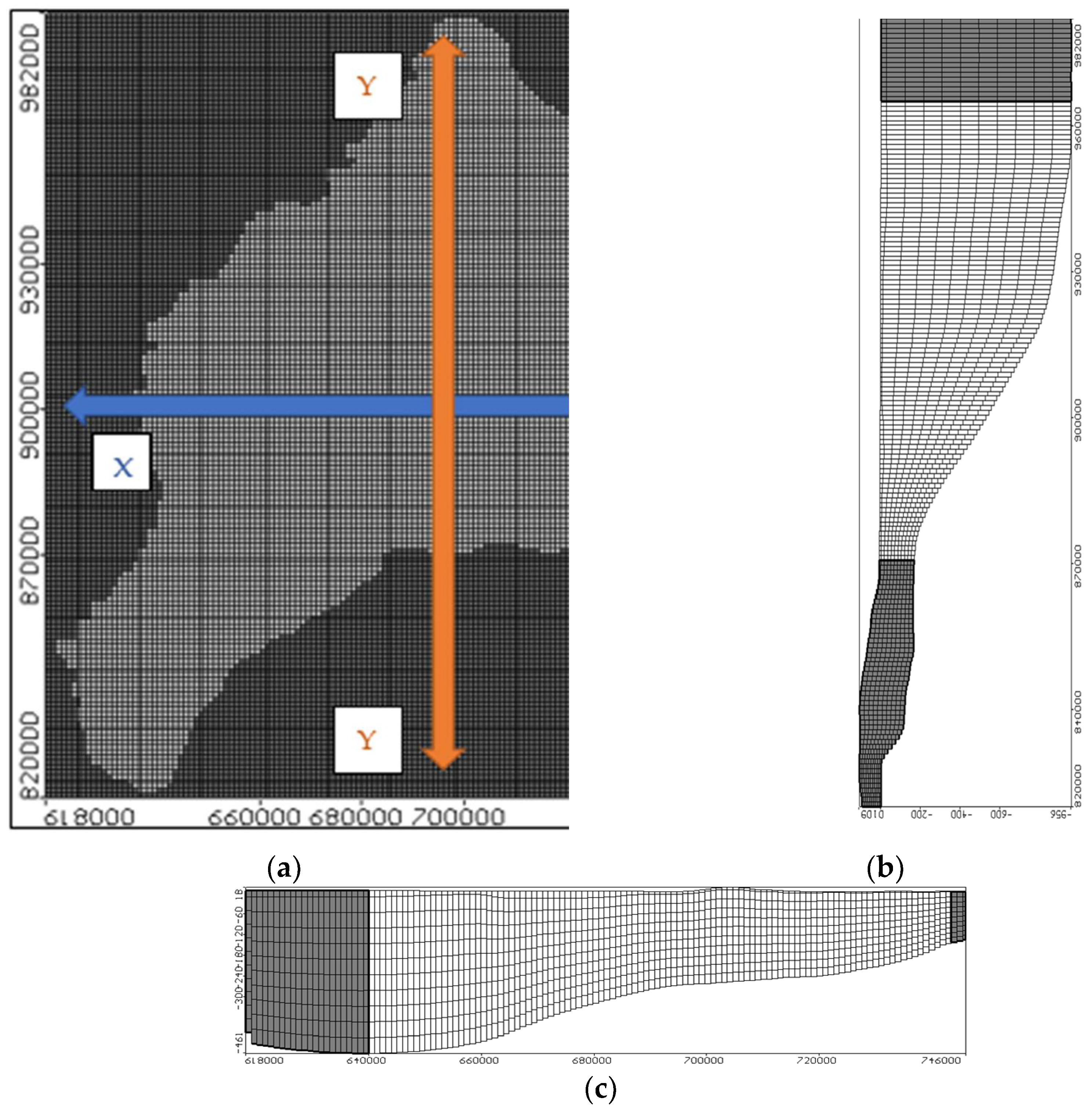
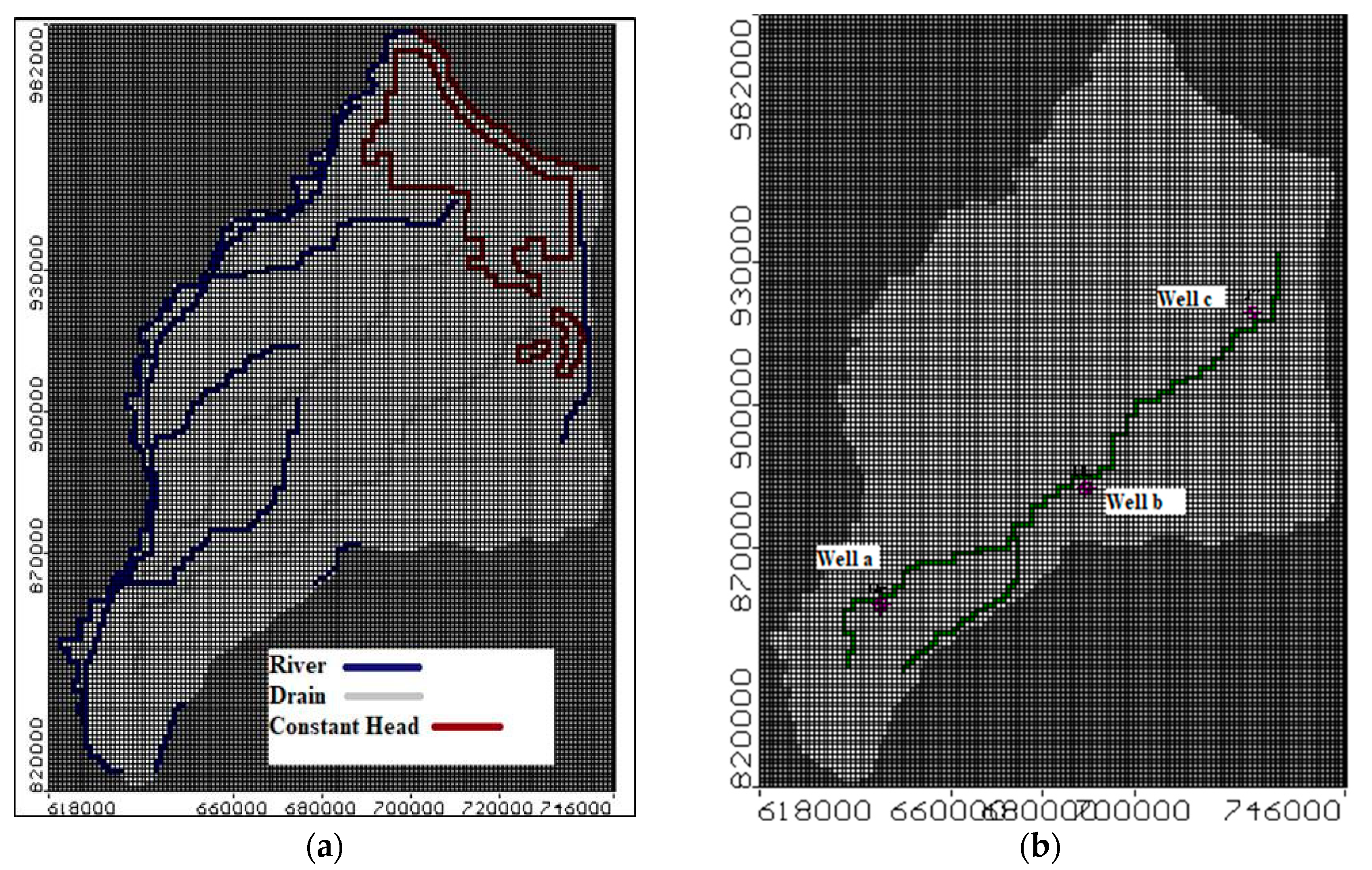
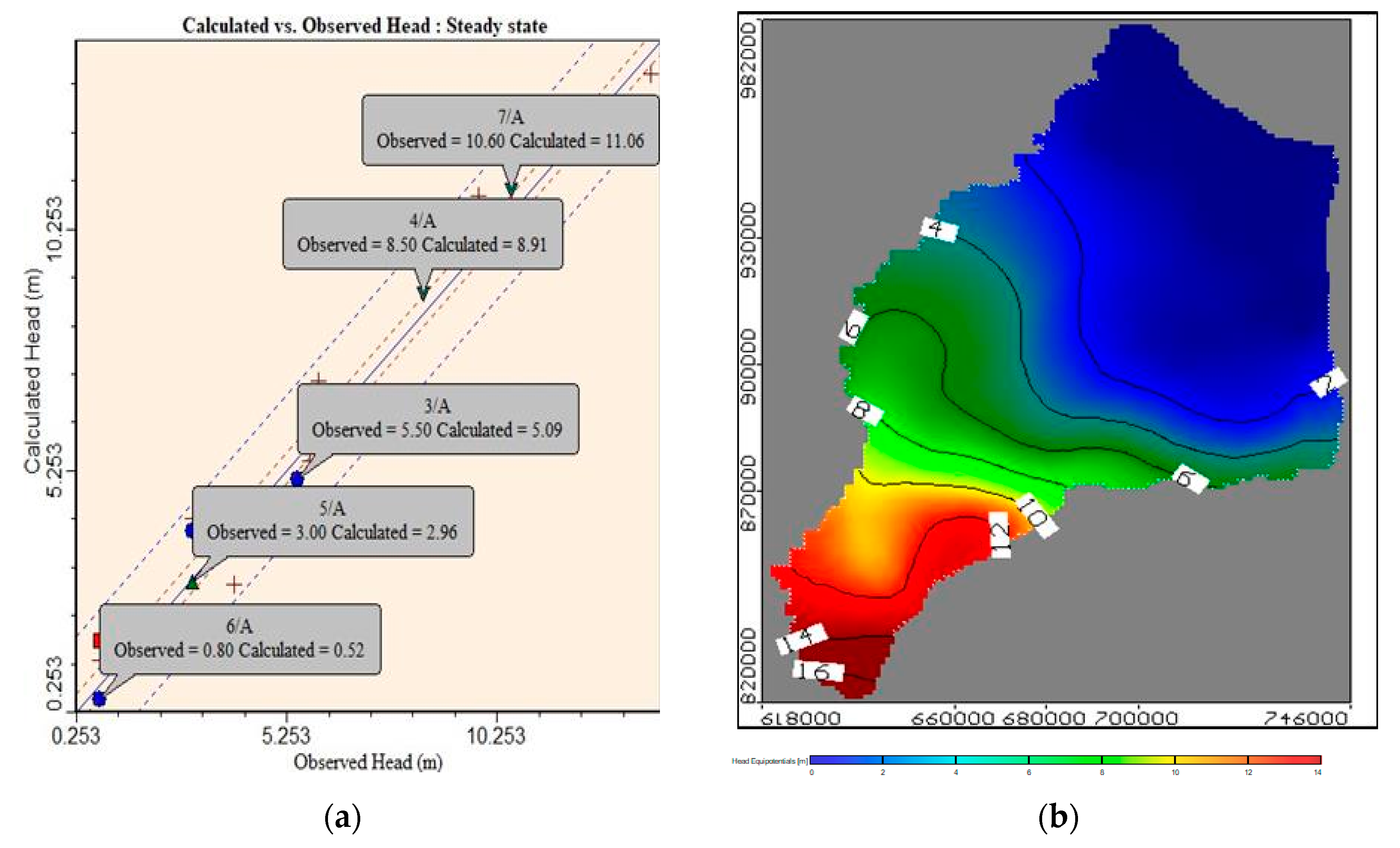
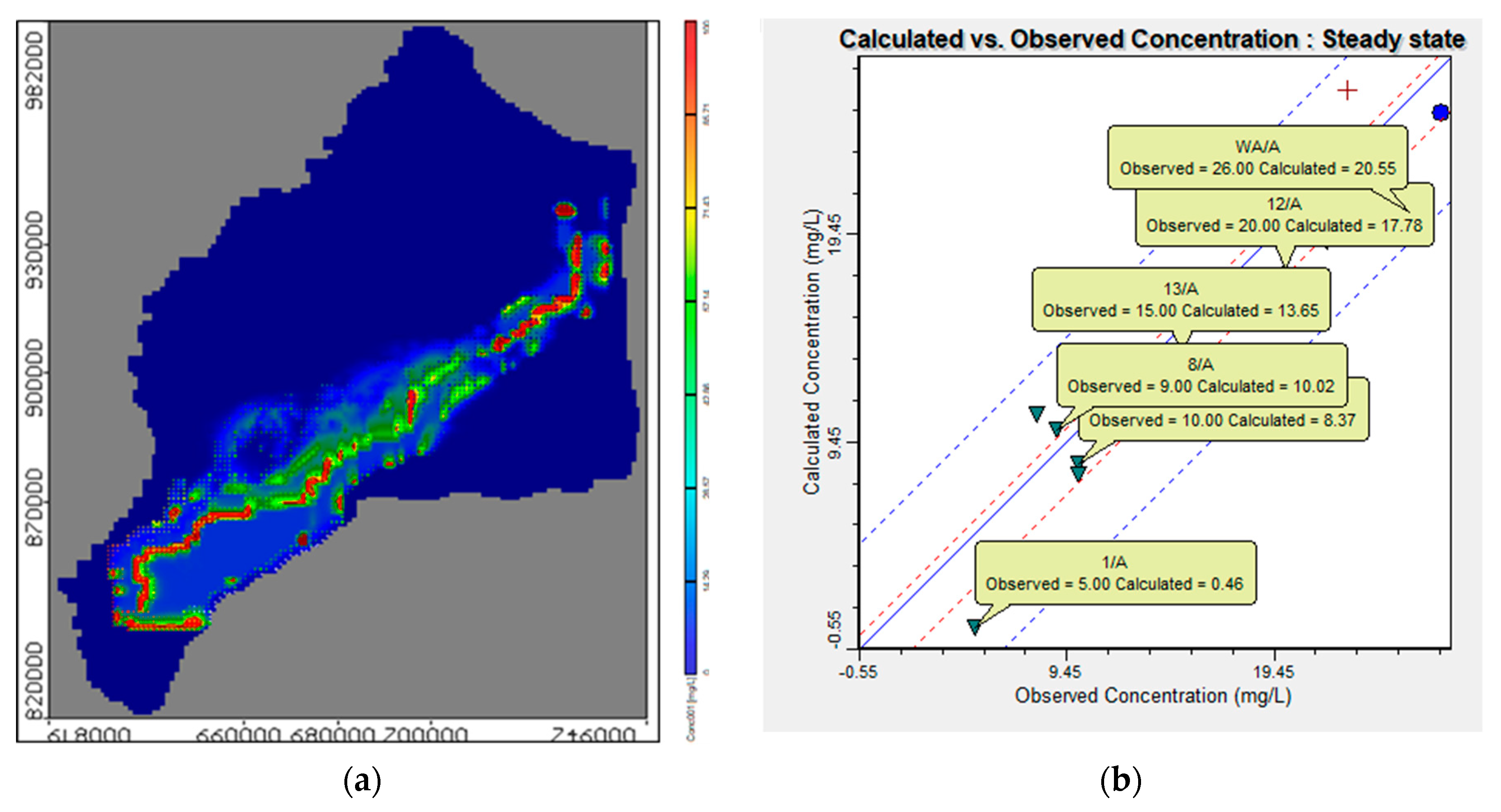
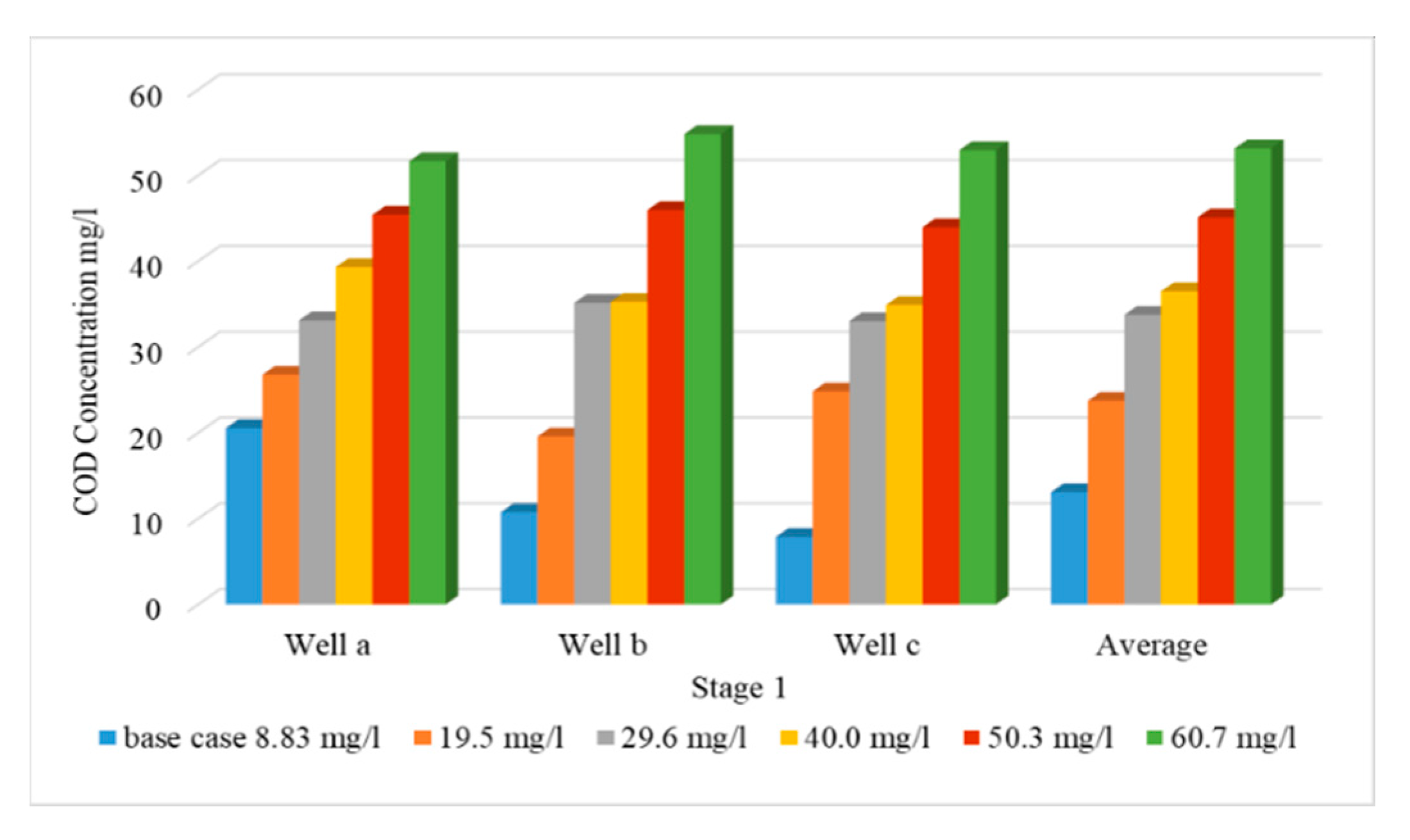
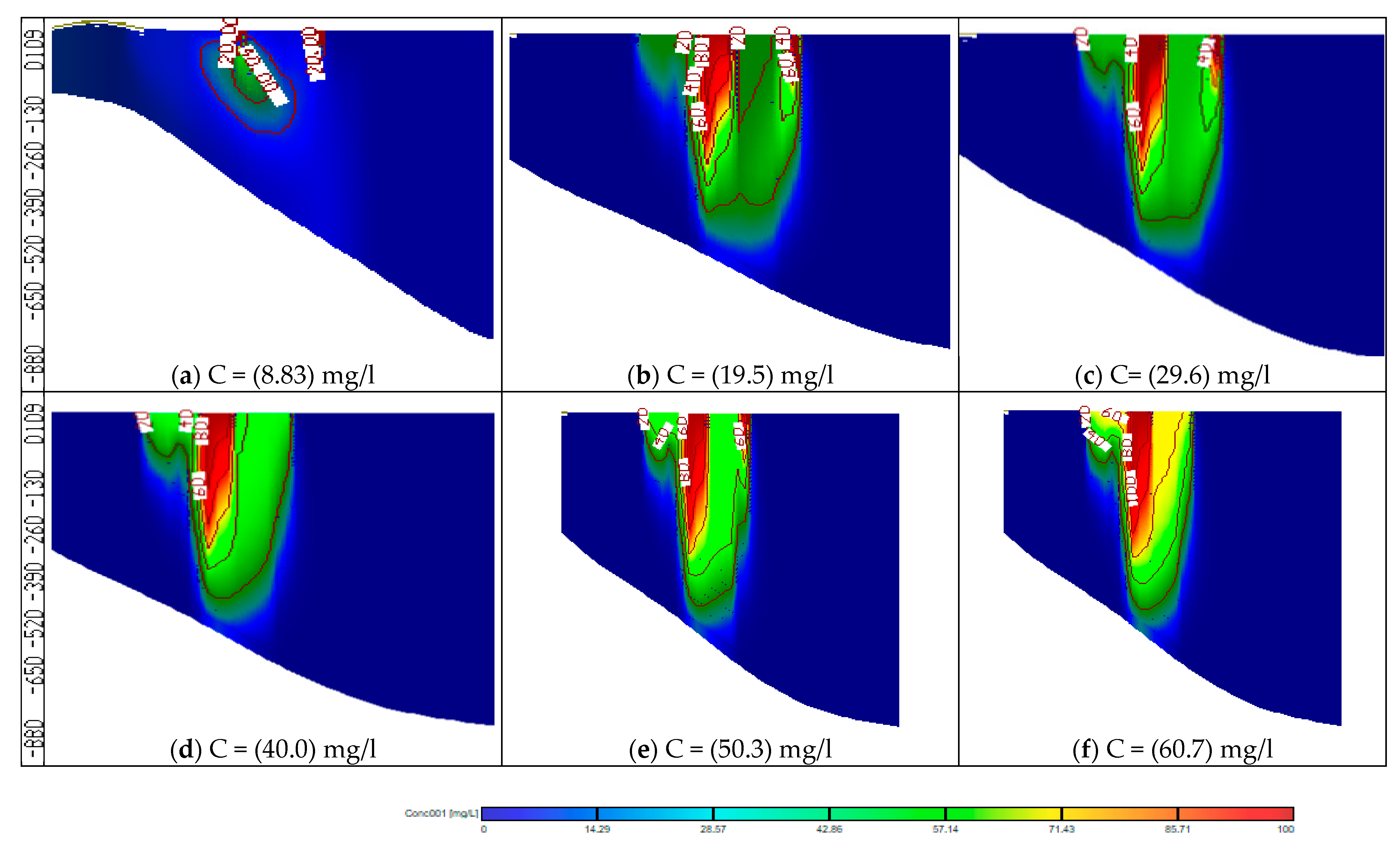
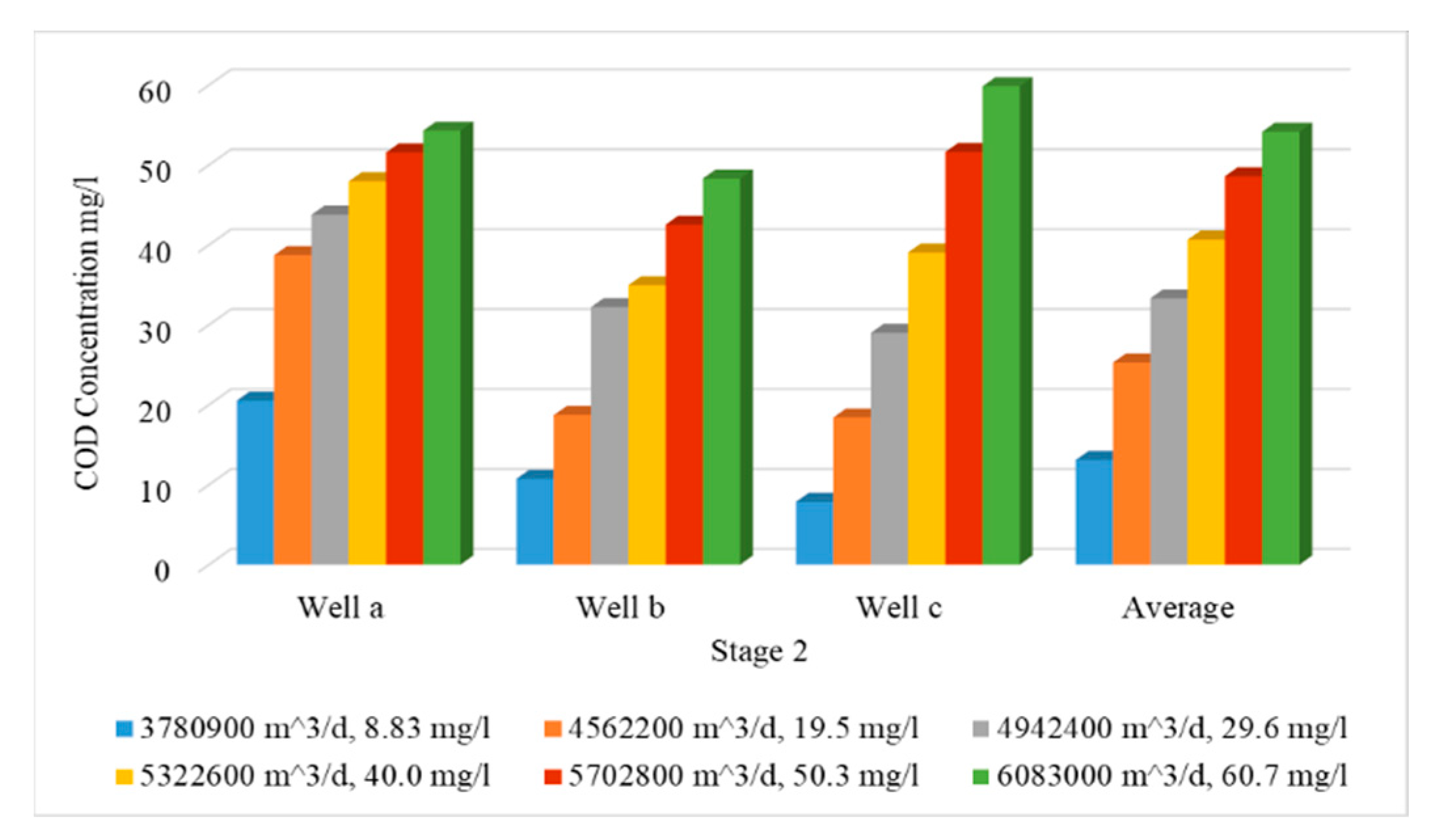
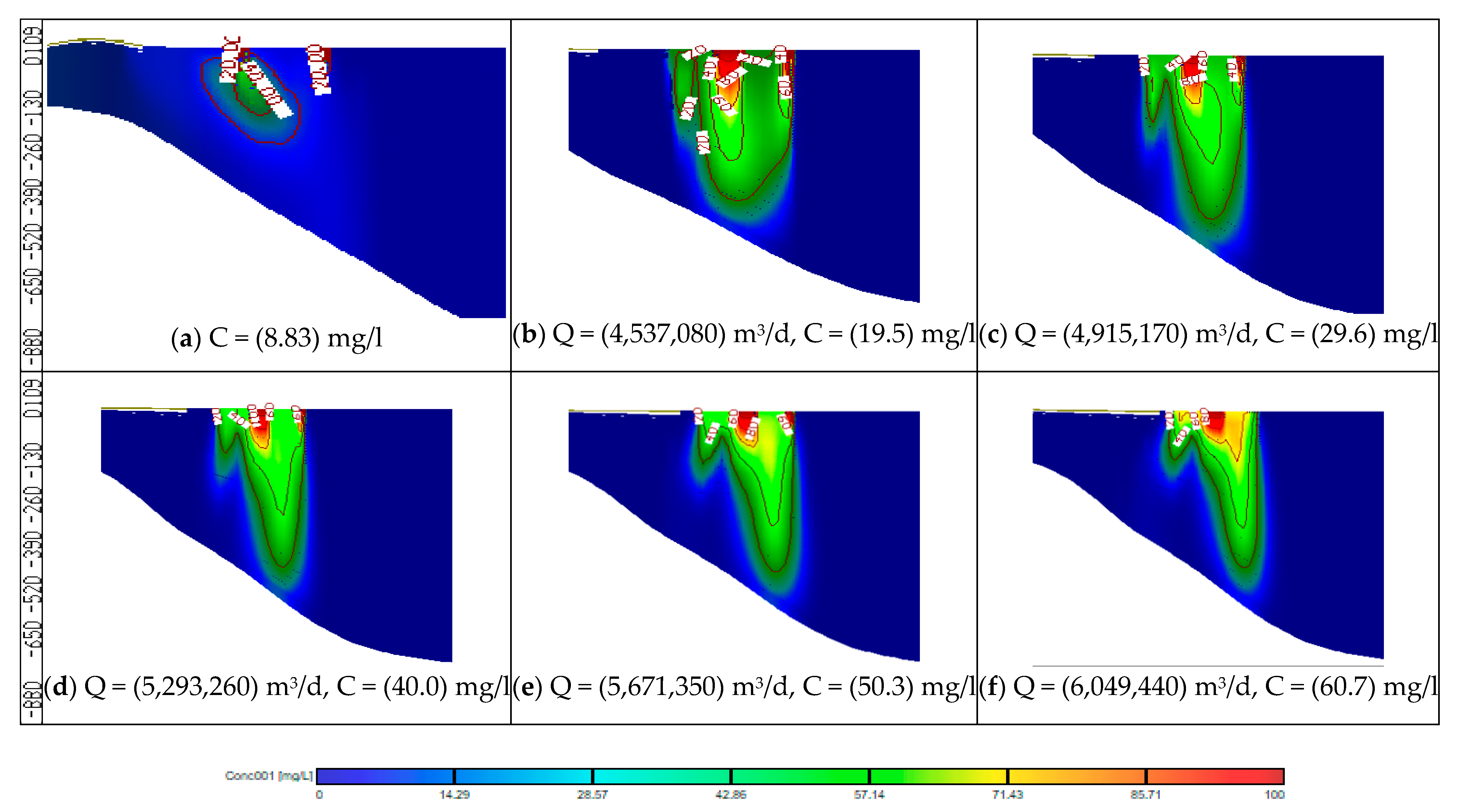
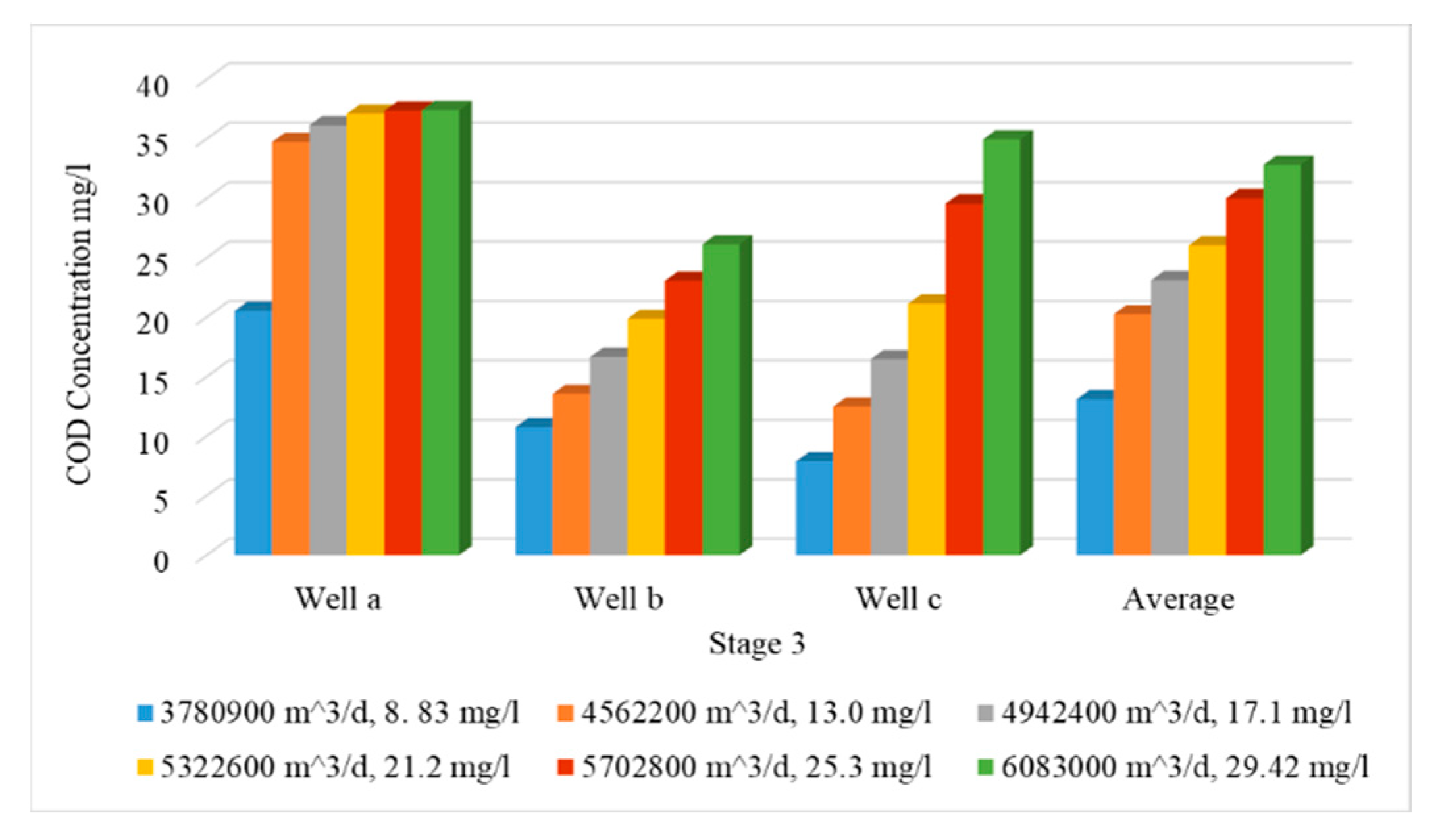
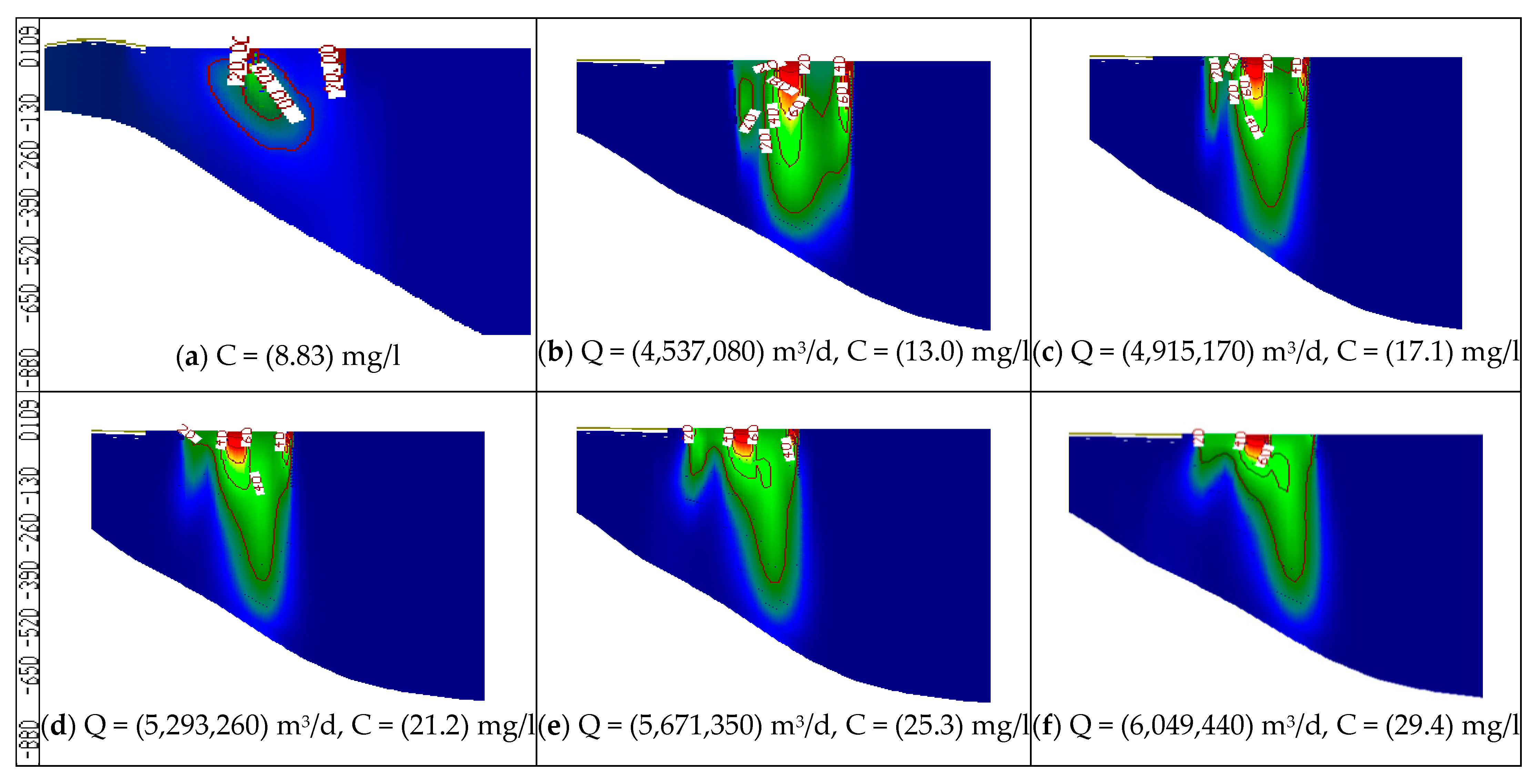
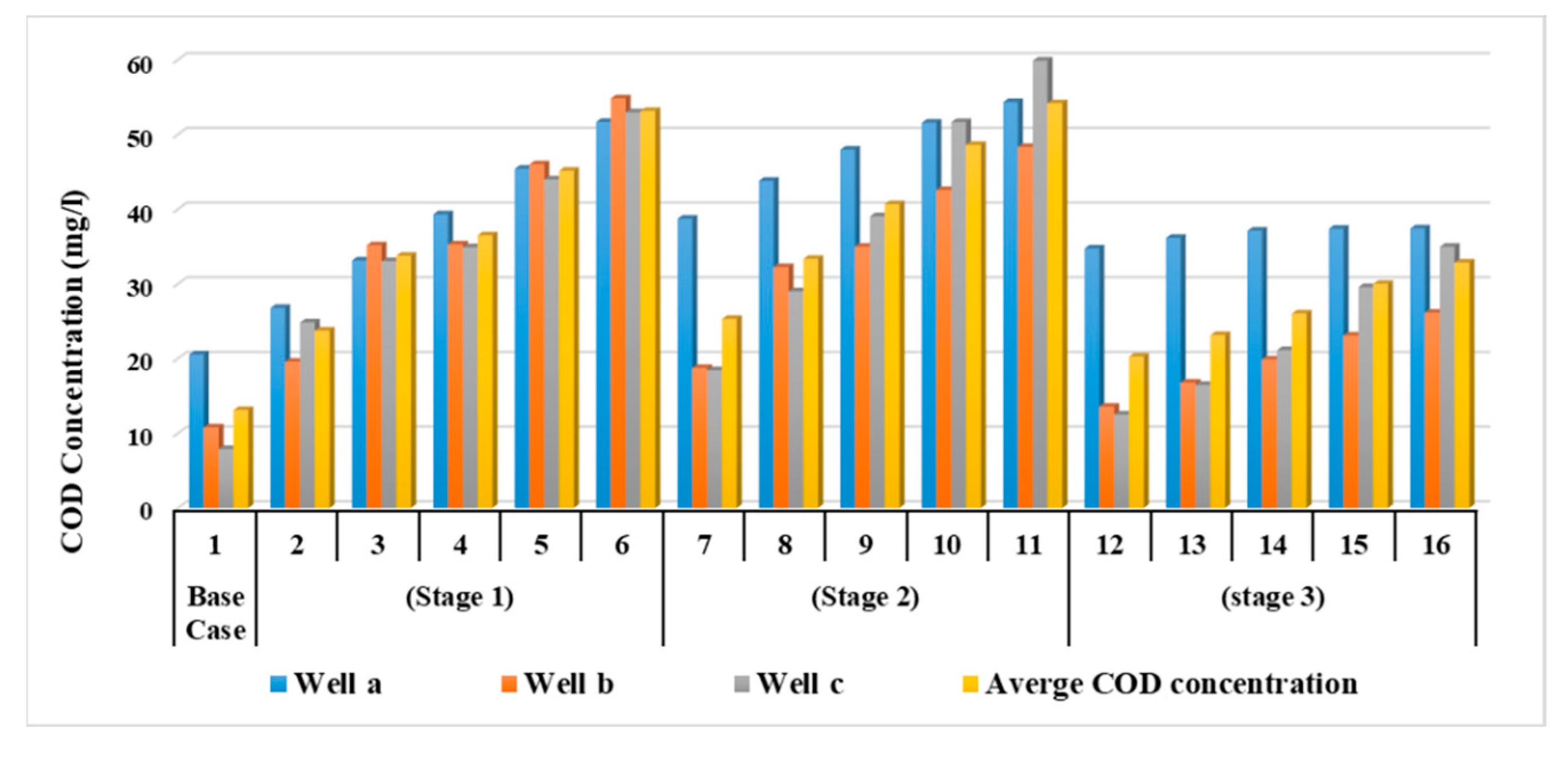
| Layer No. | 1 | 2 to 5 | 6 to 9 | 10, 11 | |
|---|---|---|---|---|---|
| Layer type | Clay | Fine sand with lenses of clay | Course sand quaternary | Graded sand and gravel | |
| Hydraulic conductivity (K) m/day | (Kh) horizontal | 0.10–0.25 | 5–20 | 20–75 | 75–100 |
| (Kv) vertical | 0.01–0.025 | 0.5–2 | 2–7.5 | 7.5–10 | |
| Specific storage (SS) (1/m) | 0.001 | 0.005 | 0.0025 | 0.0005 | |
| Specific yield (Sy) | 0.10 | 0.15 | 0.18 | 0.20 | |
| Effective porosity (neff) % | 50–60 | 30 | 25 | 20 | |
| Parameters | Inflow | Outflow | Difference |
| Constant head | 239,290 | −886,710 | −647,420 |
| Wells | 0 | −3,780,900 | −3,780,900 |
| Drains | 0 | −68,618 | -68,618 |
| Recharge | 4,299,700 | 0 | 4,299,700 |
| River leakage | 340,530 | −143,360 | 197,170 |
| Total (m3/d) | 4,879,520 | −4,879,588 | −68 |
| - | Scenario No. | Qpump (m3/d) | R (m3/d) | C (mg/L) | ||
| Base Case | 1 | 3,780,900 | 4,376,900 | 8.83 | ||
| Investigation | Untreated wastewater | 2 | 3,780,900 | Freshwater | Untreated wastewater | 19.5 |
| 90% | 10% | |||||
| 3 | 80% | 20% | 29.6 | |||
| 4 | 70% | 30% | 40.0 | |||
| 5 | 60% | 40% | 50.3 | |||
| 6 | 50% | 50% | 60.7 | |||
| Untreated wastewater with over pumping | 7 | 4,537,080 (20%) | 90% | 10% | 19.5 | |
| 8 | 4,915,170 (30%) | 80% | 20% | 29.6 | ||
| 9 | 5,293,260 (40%) | 70% | 30% | 40.0 | ||
| 10 | 5,671,350 (50%) | 60% | 40% | 50.3 | ||
| 11 | 6,049,440 (60%) | 50% | 50% | 60.7 | ||
| Management | Treated wastewater with over pumping | 12 | 4,537,080 (20%) | Freshwater | Treated wastewater | 13.0 |
| 90% | 10% | |||||
| 13 | 4,915,170 (30%) | 80% | 20% | 17.1 | ||
| 14 | 5,293,260 (40%) | 70% | 30% | 21.2 | ||
| 15 | 5,671,350 (50%) | 60% | 40% | 25.3 | ||
| 16 | 6,049,440 (60%) | 50% | 50% | 29.4 | ||
| Stage | Scenario No | Well-a (mg/L) | Well-b (mg/L) | Well-c (mg/L) | Average COD Concentration (mg/L) |
|---|---|---|---|---|---|
| Base Case | 1 | 20.55 | 10.76 | 7.88 | 13.10 |
| Stage 1 (Untreated wastewater) | 2 | 26.78 | 19.57 | 24.83 | 23.73 |
| 3 | 33.11 | 35.15 | 33.02 | 33.76 | |
| 4 | 39.31 | 35.26 | 34.90 | 36.49 | |
| 5 | 45.41 | 45.99 | 43.98 | 45.13 | |
| 6 | 51.66 | 54.82 | 52.96 | 53.13 | |
| Stage 2 (Untreated wastewater with over-pumping) | 7 | 38.73 | 18.72 | 18.43 | 25.30 |
| 8 | 43.79 | 32.24 | 28.99 | 33.34 | |
| 9 | 47.96 | 34.97 | 39.05 | 40.66 | |
| 10 | 51.57 | 42.55 | 51.64 | 48.60 | |
| 11 | 54.32 | 48.32 | 59.87 | 54.17 | |
| Stage 3 (Treated wastewater with over-pumping) | 12 | 34.74 | 13.55 | 12.49 | 20.26 |
| 13 | 36.15 | 16.76 | 16.47 | 23.13 | |
| 14 | 37.11 | 19.86 | 21.13 | 26.03 | |
| 15 | 37.37 | 23.07 | 29.56 | 30.00 | |
| 16 | 37.41 | 26.13 | 34.96 | 32.83 |
Publisher’s Note: MDPI stays neutral with regard to jurisdictional claims in published maps and institutional affiliations. |
© 2022 by the authors. Licensee MDPI, Basel, Switzerland. This article is an open access article distributed under the terms and conditions of the Creative Commons Attribution (CC BY) license (https://creativecommons.org/licenses/by/4.0/).
Share and Cite
Abd-Elaty, I.; Abd-Elmoneem, S.M.; Abdelaal, G.M.; Vrána, J.; Vranayová, Z.; Abd-Elhamid, H.F. Groundwater Quality Modeling and Mitigation from Wastewater Used in Irrigation, a Case Study of the Nile Delta Aquifer in Egypt. Int. J. Environ. Res. Public Health 2022, 19, 14929. https://doi.org/10.3390/ijerph192214929
Abd-Elaty I, Abd-Elmoneem SM, Abdelaal GM, Vrána J, Vranayová Z, Abd-Elhamid HF. Groundwater Quality Modeling and Mitigation from Wastewater Used in Irrigation, a Case Study of the Nile Delta Aquifer in Egypt. International Journal of Environmental Research and Public Health. 2022; 19(22):14929. https://doi.org/10.3390/ijerph192214929
Chicago/Turabian StyleAbd-Elaty, Isamil, Shaimaa M. Abd-Elmoneem, Gamal M. Abdelaal, Jakub Vrána, Zuzana Vranayová, and Hany F. Abd-Elhamid. 2022. "Groundwater Quality Modeling and Mitigation from Wastewater Used in Irrigation, a Case Study of the Nile Delta Aquifer in Egypt" International Journal of Environmental Research and Public Health 19, no. 22: 14929. https://doi.org/10.3390/ijerph192214929






